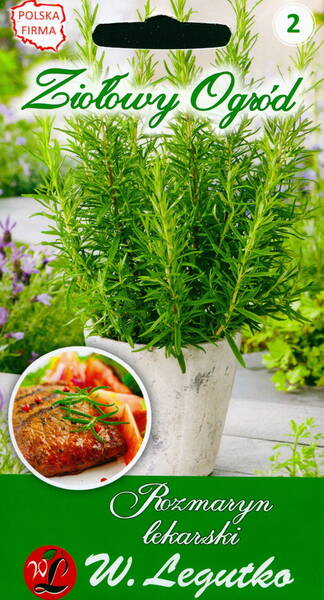Your shopping cart is empty!
Rosemary "Dew of the Sea"
Rosemary "Dew of the Sea" - Rosmarinus officinalis L.
Perennial evergreen ethereal plant from the Lamiaceae family. Height 40-60 cm. The flowers are small, collected in dense paniculate inflorescences, colouring from dark purple to white. Resistant to diseases and pests.
A plant with straight densely leafy shoots. The leaves are linear, curled along the edge and glossy above. The flowers are honey-bearing, small, light blue and purple, located in the axils of the upper leaves. Rosemary blooms from March to May. Often secondary flowering is in autumn (September-October).
It is drought-resistant, exacting to light and sensitive to frosts. In the temperate zone, it is recommended to grow it in pots or tubs. For the winter, place in unheated bright rooms.
It has a sweetish spicy aroma and a strongly pronounced taste, valuable medicinal properties. Heat-loving and drought-resistant.
Leaves and young shoots begin to be collected in July-August.
In cooking, it is used as a spicy-flavouring additive to meat and vegetable dishes. It is an excellent firming and tonic agent.
A small amount of rosemary is added to fruit salads, hot vegetable and meat dishes, brewed into tea.
1.0 g = 550-750 seeds.
Agricultural technology.
Propagated by seeds, cuttings, division of the bush and layering.
Seeds are sown for seedlings in March-April. Sowing in the ground in May-June. Shoots appear unevenly, within 2 months.
Seedlings are planted in open ground in late May-early June.
Rosemary is drought tolerant, demanding light and sensitive to frost. Prefers dry calcareous permeable soils with good aeration. It also grows on dry sandy and gravelly soils. Does not tolerate excessive moisture.
Under rosemary allot areas on the southern slopes. Plants are planted in autumn or early spring with a feeding area of 1.5 x 1 m.
Plant care consists in timely loosening, removal of weeds and application of nitrogen and phosphorus fertilizers. Harvested in July-August.
Perennial evergreen ethereal plant from the Lamiaceae family. Height 40-60 cm. The flowers are small, collected in dense paniculate inflorescences, colouring from dark purple to white. Resistant to diseases and pests.
A plant with straight densely leafy shoots. The leaves are linear, curled along the edge and glossy above. The flowers are honey-bearing, small, light blue and purple, located in the axils of the upper leaves. Rosemary blooms from March to May. Often secondary flowering is in autumn (September-October).
It is drought-resistant, exacting to light and sensitive to frosts. In the temperate zone, it is recommended to grow it in pots or tubs. For the winter, place in unheated bright rooms.
It has a sweetish spicy aroma and a strongly pronounced taste, valuable medicinal properties. Heat-loving and drought-resistant.
Leaves and young shoots begin to be collected in July-August.
In cooking, it is used as a spicy-flavouring additive to meat and vegetable dishes. It is an excellent firming and tonic agent.
A small amount of rosemary is added to fruit salads, hot vegetable and meat dishes, brewed into tea.
1.0 g = 550-750 seeds.
Agricultural technology.
Propagated by seeds, cuttings, division of the bush and layering.
Seeds are sown for seedlings in March-April. Sowing in the ground in May-June. Shoots appear unevenly, within 2 months.
Seedlings are planted in open ground in late May-early June.
Rosemary is drought tolerant, demanding light and sensitive to frost. Prefers dry calcareous permeable soils with good aeration. It also grows on dry sandy and gravelly soils. Does not tolerate excessive moisture.
Under rosemary allot areas on the southern slopes. Plants are planted in autumn or early spring with a feeding area of 1.5 x 1 m.
Plant care consists in timely loosening, removal of weeds and application of nitrogen and phosphorus fertilizers. Harvested in July-August.


Eng.: Rosemary, dew of the sea. Bot.: Rosmarinus officinalis L. Pharm.: folia anthos, folia roris marini.











